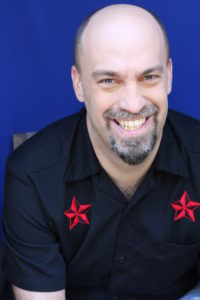Folger’s rendering of the seldom-produced King John is more than impressive Shakespearean rhetoric and the checking off on a bucket list of plays to produce. With a deft touch, director Aaron Posner fashioned an inspired, emotional texture for King John.

The characters, including the melancholy, stumbling King himself (a rich portrayal by Brian Dykstra), are haunted people with plentiful flaws. They are far from untarnished, iconic Royals. No need to bow and genuflect before them.
But this column is not about the sumptuous acting by a commanding cast in King John or even Shakespeare’s dazzling dialogue. For a review of King John, my DCMTA colleague Ian Thal’s fine take is here.
Instead, this column is to give richly deserved notice to the inventive sound design and original music by Lindsay Jones that becomes another character in the production. With imaginative, impactful sound design, this is no King John in which “Life is as tedious as a twice-told tale, vexing the dull ear of a drowsy man.”
With his creative sound and music, Jones brings laser-sharp attention in service to the performances on stage. Let me provide two examples. They are quite different in nature.
During battle scenes in which “the cannons have their bowels full of wrath,” the sound design Jones developed provides an utterly real sense of the dangerous, deafening nature of war. There is the audible chaos that a warrior (Philip Faulconbridge adeptly played by Kate Eastwood Norris) faces as deafening sounds and martial music come from all sides. It is no heroic frontal attack. Jones creates sounds that gave me a sense of a visceral adrenaline rush that a warrior must feel. Add in Max Doolittle’s blinding lighting schemes for battle scenes, well, there is a realistic disorientation of sight and sound.
Then with a much quieter solo scene, Jones creates sounds signifying the inner psychological turmoil of the young boy Arthur (finely portrayed by Megan Graves). Arthur is a possible heir to the throne King John occupies. In a scene fraught with deep internal psychological verisimilitude, the sound design took me inside a young boy’s struggles to decide what to do next as he stands on a high castle precipice. “The wall is high, and yet will I leap down: Good ground, be pitiful and hurt me not!” Arthur thinks out loud. What sounds did I hear? How about a muffled, slow, imperceptible wail as Arthur struggled with what to do. Should he jump? Would he survive? When he finally took action, well, it seemed to me from an unbearable height, even though the stage jump was perhaps two feet.

I wanted to know more from Jones about how he does what he does as a sound designer. In a phone interview, Jones noted that he “was always interested in music and sound.” Originally he had trained to be an actor at the North Carolina School of The Arts. How did he then become a sound designer? By happenstance.
In his mid-20s, Jones was asked to develop music and sound for a production in Chicago. He was playing gigs in a rock band when “the production needed his rock band musician skills.” He moved into sound design and creating original music on a full-time basis over time. Over the decades he has received numerous honors and awards for his work in theaters across America.
In developing the sound design for a theater production, Jones noted that he meets with the director “to learn the message the director wants to create and send.” These theatrical ideas lead him “to create an initial palette of sounds and instruments to make the sounds and orchestration. It is a palette of sonic textures tailored to the specific production.”
In a collaborative process, Jones sits in on an early read-through rehearsal. “At the table read he hears the actors and further develops the sound design as he hears their voices,” he said. For Jones, the “early run-through with the actors read is inspiring. Sounds begin to further come together. I hear the music almost write itself as I watch and listen.” He thinks how sound can highlight key moments and scenes, how sound and music can become “a framing device.”
I asked Jones a question specific to King John. What instruments did he use? How did he make them sound as they did?
For Folger’s King John, Jones used three levels of instruments. First were accordion and melodica in a grouping. The next level included trombones, a third level included drums. The various instruments were then orchestrated and mixed to fit a particular scene. For King John battle scenes, the instruments were loud and strong, full of sound and fury. And yet the instruments maintained an individual personality. The same instruments were arranged much differently for the quieter scene with Arthur standing on the high ledge. But this time the music was played at an extremely slow speed with a more muted tone. Individual instruments were impossible for me to perceive. What I heard were the inner workings of Arthur’s brain deciding what he should do: to jump or not.
When Jones was asked how someone should listen and judge sound design in a theater production, he suggested this: After a performance, reflect on the experience with the play. What did the sound add? What would the performance have been like without the sound or the music? Then decide what the sound did.
With Jones’s work, Folger’s King John soared. I can’t imagine it would have done so without Lindsay Jones and his sound design and original music. He created the aural character that helped the living, breathing actors make the production ascend.
Running Time: Two hours and 30 minutes with a 15-minute intermission.
King John plays through December 2, 2018 at The Folger Theatre at 201 East Capitol Street SE, Washington, DC. For tickets call (202) 544-7077 or order online.




